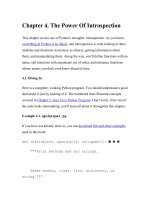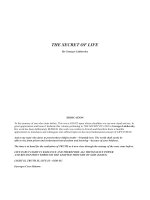4 4 4 the rosetta stone and the secret of hieroglyphics
Bạn đang xem bản rút gọn của tài liệu. Xem và tải ngay bản đầy đủ của tài liệu tại đây (2.86 MB, 10 trang )
Suggested levels for Guided Reading, DRA,™
Lexile,® and Reading Recovery™ are provided
in the Pearson Scott Foresman Leveling Guide.
THE
Rosetta Stone
and the Secret of Hieroglyphics
Genre
Expository
nonfiction
Comprehension
Skills and Strategy
• Graphic Sources
• Draw Conclusions
• Ask Questions
Text Features
•
•
•
•
Heads
Map
Chart
Glossary
Scott Foresman Reading Street 4.4.4
ISBN 0-328-13466-X
ì<(sk$m)=bdeg d< +^-Ä-U-Ä-U
by Ellen B. Cutler
Reader Response
1. Look at the table on page 10. In a chart similar
to the one below, write the glyphs for the letter
sounds of p, t, and l.
Glyph
Sound
p
t
l
The Rosetta Stone
2. What questions did you have while you read?
Where can you go to find more information
about hieroglyphics?
and the Secret of Hieroglyphics
3. What does the prefix un- in uncover mean? What
are other words with the prefix un-?
by Ellen
B. Rosetta
Cutler Stone on page
4. Look at the picture
of the
11. In which band can you find the demotic script?
Editorial Offices: Glenview, Illinois • Parsippany, New Jersey • New York, New York
Sales Offices: Needham, Massachusetts • Duluth, Georgia • Glenview, Illinois
Coppell, Texas • Ontario, California • Mesa, Arizona
A Discovery
The year was 1799. France was at war with
England. Soldiers were hard at work in the hot sun
building a fort. The soldiers had traveled far from their
homes in France to work in Rosetta, Egypt. Rosetta is
located where the western Nile River Delta meets the
Mediterranean Sea.
Rosetta, Egypt
MEDITERRANEAN SEA
Rosetta
Every effort has been made to secure permission and provide appropriate credit for
photographic material. The publisher deeply regrets any omission and pledges to
correct errors called to its attention in subsequent editions.
Unless otherwise acknowledged, all photographs are the property of Scott Foresman,
a division of Pearson Education.
Photo locators denoted as follows: Top (T), Center (C), Bottom (B), Left (L), Right (R),
Background (Bkgd)
Opener: ©DK Images; 1 ©DK Images; 3 ©DK Images; 4 Art Resource, NY; 6 ©DK
Images; 8 ©DK Images; 9 ©DK Images; 10 ©DK Images; 12 ©DK Images; 15 ©DK
Images
NILE RIVER
ISBN: 0-328-13466-X
Copyright © Pearson Education, Inc.
All Rights Reserved. Printed in the United States of America. This publication is
protected by Copyright, and permission should be obtained from the publisher
prior to any prohibited reproduction, storage in a retrieval system, or transmission
in any form by any means, electronic, mechanical, photocopying, recording, or
likewise. For information regarding permission(s), write to: Permissions Department,
Scott Foresman, 1900 East Lake Avenue, Glenview, Illinois 60025.
2 3 4 5 6 7 8 9 10 V0G1 14 13 12 11 10 09 08 07 06 05
EGYPT
3
The conflict between France and England had
spread all the way to Egypt. General Napoleon
Bonaparte brought his French soldiers to this country.
He wanted to take over the land. He also brought
painters, scientists, and scholars with him. These
people would study Egyptian art, history, and language.
Bonaparte was interested in learning about Egyptian
culture as well.
Bonaparte’s troops dug through the sand in search
of stone that they could use to build a fort. They came
upon an unusual piece of rock. It was a piece of black
basalt. The edges were broken. It was clear that this
long slab of stone had once been used as a marker or a
sign.
The slab had three wide bands of writing. The
writing on the top band was Egyptian hieroglyphics.
This was a kind of picture writing that no one
knew how to read anymore. The text in the
middle was written in demotic script. Demotic
script was a simplified form of hieroglyphics.
A few people were able to understand some
of this writing. The bottom band was written
in ancient Greek, a language known to many
scholars.
General Napoleon Bonaparte’s troops at the
Battle of Aboukir Bay in Egypt
4
5
The Stone
The stone the troops discovered is known as the
Rosetta Stone. The discovery of the Rosetta Stone
made people excited all around the world. It would be
a clue to figuring out the lost language of the ancient
Egyptians. It was clear to scholars, or people who have
much knowledge, that all three bands were inscribed,
or written, with the same message. For a long time
people had struggled to understand hieroglyphics——the
script that combined letters and pictures. The Rosetta
Stone would help them make sense of this ancient
form of writing.
Scholars knew they could translate the
hieroglyphic text by comparing it to the demotic
script and the ancient Greek writing. The words
they know would be the link to the unknown ones.
Scholars would use the Greek text that they knew and
understood to help them read the demotic script. The
demotic script would help them uncover the meaning
of the ancient Egyptian hieroglyphs. Knowing how
to read hieroglyphics would help scholars learn more
about the Egyptian civilization.
The Rosetta Stone
6
7
Egyptian Culture
The ancient civilization of Egypt grew up along
the banks of the Nile River. Water flooded over the
riverbanks every year. This left behind a rich, deep soil
that allowed all kinds of crops to grow. Wide deserts
on the east and the west protected Egypt from its
opponents. Egypt also had a long seacoast with harbors.
Egyptians sailed to distant lands and traded goods. They
built beautiful temples. The country grew rich.
Various wars brought Egypt under Persian, Greek,
and then Roman control. In 30 B.C., Egypt became part
of the Roman Empire. By this time only a few priests
still knew and used hieroglyphics. Fewer people used
this ancient form of writing as time went on, because
other forms of writing were easier to use. Slowly, the
writing system was lost. No one could read or write
hieroglyphics. Over time they had forgotten how.
Inside an Egyptian temple
Egyptian mummy case
8
9
The Ancient Writing
The hieroglyphics system had
developed in Egypt soon after 3000
p
B.C. The symbols, or glyphs, used in
t
the writing changed very little over
l
the next twenty-six hundred years.
There are between seven hundred and eight
hundred symbols in Egyptian hieroglyphics. Compare
that to the twenty-six letters in the English alphabet!
Some of the Egyptian symbols stand for sounds. Other
symbols stand for objects or ideas.
The ancient Egyptians believed that writing made
words and ideas live
forever. They called
hieroglyphics the
“language of the gods.”
Priests used hieroglyphics
to decorate the walls of
their temples with prayers
and stories. Sometimes
hieroglyphics were carved
on wooden objects such
as furniture or on jewelry.
Glyph
Sound
Hieroglyphics were difficult to learn and took a long
time to write out, even for the ancient Egyptians. Also,
the Egyptians invented a form of writing called hieratic
script that was easier to use. Later this became demotic
script that was even easier to write.
Hieroglyphic
Demotic
Greek
Hieroglyphics on an
Egyptian stamp
10
11
Finding the Key
Copies of the Rosetta Stone texts were sent to
scholars all around Europe. Reading the hieroglyphics
was difficult for scholars. Figuring out the meaning of
each glyph was hard, slow work.
Everyone had a different idea about how to uncover
the meaning. Was every symbol a picture that had a
specific meaning? What did the squiggles and squares
and other shapes mean? Were they meant to be read
from left to right, from right to left, up and down?
It took people years to learn to read hieroglyphics.
They had to do more than compare the three different
forms of writing on the Rosetta Stone. They also
compared the hieroglyphics on the stone to those they
found on temple walls and sculptures in Egypt.
One thing they discovered was that a cartouche
was a line of hieroglyphics enclosed in an oval shape.
The cartouche stood for a person’s name. Some of the
first glyphs to be translated were the ones used for the
names of kings and queens.
Cartouches on the outside wall
of an Egyptian temple
12
13
Most of the credit for figuring out hieroglyphics
belongs to a French man named Jean-François
Champollion. He lived from 1790 to 1832.
Champollion was a seeker of knowledge. He was
good at learning languages. He was also interested in
Egyptian culture. His family told him to pursue his
interests. Champollion decided that one day he would
learn to read hieroglyphics.
Finally, Champollion found triumph. All of the
time he had spent studying Egypt helped him to figure
out sounds and whole ideas. Champollion had found
the key to unlocking hieroglyphics.
French soldiers uncovered the Rosetta Stone in
the Egyptian desert. Now the stone is displayed in
the British Museum in London, England. The Rosetta
Stone has been on display since 1802. You can still see
it there today.
14
What story does the Rosetta Stone hold? It was
made in 196 B.C. This was nine years after Ptolemy V
had been crowned pharaoh, or king. The Rosetta Stone
praises Ptolemy. It tells of the good he did for Egypt.
But the Rosetta Stone’s message had faded into the
past. Scholars put time into research and study. They
were able to bring this piece of history back to life.
Jean-François Champollion
15
Glossary
Reader Response
ancient adj. of times
long past.
temples n. buildings
used for worship.
link n. anything that
joins or connects.
translate v. to change
from one language into
another.
scholars n. people who
have much knowledge.
seeker n. one who
tries to find; one who
searches.
1. Look at the table on page 10. In a chart similar
to the one below, write the glyphs for the letter
sounds of p, t, and l.
Glyph
Sound
triumph n. victory;
success.
p
uncover v. to make
known; reveal; expose.
t
l
2. What questions did you have while you read?
Where can you go to find more information
about hieroglyphics?
3. What does the prefix un- in uncover mean? What
are other words with the prefix un-?
4. Look at the picture of the Rosetta Stone on page
11. In which band can you find the demotic script?
16









